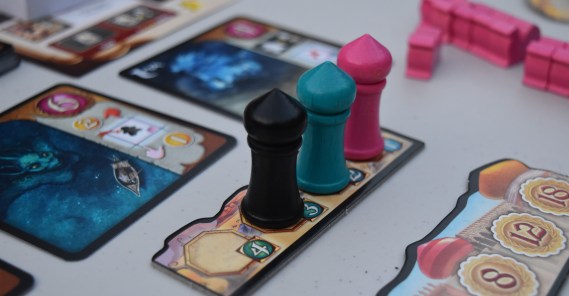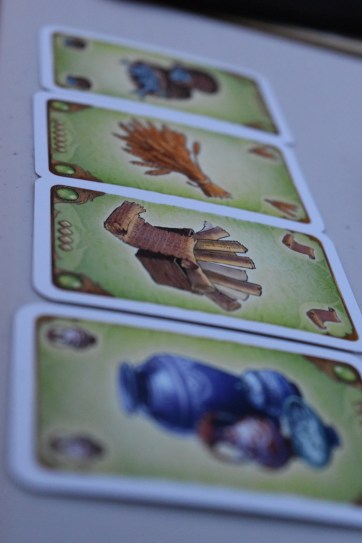Pairs well with: Any old cocktail so long as it has an umbrella in it. You’ll be needing that shade.
Brutus rating: 2/10 for picking the meeple the other person wanted GODDAMNYOU
Aren’t you guys lucky – this week we have a super exciting time-lapse of our game of Five Tribes thanks to our lovely friend Pete! Enjoy and keep on reading.
Have you ever wanted to own your own camel herd? A golden palace? How about controlling all-powerful djinn for your mischievous bidding?
It may sound like it’s taken straight out of a Disney film, but trust us, Five Tribes has all of the hallmarks of a great fantasy board game.
Five Tribes first grabbed our attention back in Essen Spiel, 2015. Brightly coloured and beautifully charismatic it was no surprise that Days of Wonder were pushing it to as many people as possible. Fortunately for Days of Wonder, the Misery Farmers were in fact drawn to the camels.
‘Holy shit it has camels. Like, a lot of camels. At least four camels. Guys, stop, we’re playing this. We need to see if it can compare to Camel Cup…’
The game is set in the mythical land of N’quala, where the design and artwork of the game leave little to the imagination. The aim of is to use the five different tribes – the varying coloured meeple who are randomly allocated across the board – to control the kingdom. In short you’ll need to collect the most money (which double up as victory points), where you may dictate, sat atop your pile of cash.
Confusingly, that means that Five Tribes is NOT for five people. Five meeple, not five people. Cast away that spare friend and get them to be in charge of snacks.

Now, let’s get back to those tribes. A round kicks off with some jostling about turn order which relies on a bidding mechanic. After this, each player selects one square of randomly coloured meeple, each of which have a different profession, and therefore have a different action associated with them. Blues are builders, they gather you money based on the surrounding tiles. Reds are assassins, they allow you to kill lone and undefended meeple. Whites are elders, they summon djinn who may grant you extra actions. Etc, etc.

Wait! So the five different tribes are each a different colour? And any meeple of the same colour has the same profession?
Yep. N’quala is definitely not a place of very cleverly distributed jobs. No idea what you do if you want to build something and you’re not the builder tribe, for example. Pff. And what, when your hair starts to go grey do you go and leave your family to join the elders tribe? I mean I know a few badass old people but as a rule they must suck pretty hard at most things, like manual labour.
 However it normally works, they’re all gathered together and mixed up at the moment. Probably for the best.
However it normally works, they’re all gathered together and mixed up at the moment. Probably for the best.
The key to this game is looking very, very intently at which squares to begin and end your turn with. Choose which action you want to achieve carefully before moving anything.
‘Right, that’s my turn… hmm… no… I’ve done this wrong, can I try again? Does anyone remember which order of different colour meeple I put where? Did I pick up 4 or 5 to begin with? Oh God, which tile did I start with, they all look so similar…’
^^Literally, fuck you. Don’t be that asshole.
To be fair, it’s a little unintuitive before you get used to it. You pick up all of the meeples from one tile and then spread them around one at a time on each tile as you move in any non-diagonal direction you like. You have to end on a tile with at least one meeple of the colour you’re about to put on it, and then you pick both of those up to keep or put away. That’s probably how the game has been described by our friends both as “reverse-worker-placement” and “the tidying-away game”.
The number of meeple you pick up on your last tile dictates just how much of that action you can do. For example, picking up three reds allows you to kill a piece up to three squares away. Not entirely sure how that one works, perhaps their morale allows them to travel faster if they’re egging each other on.

As well as taking actions through meeple, each board square has a symbol on the bottom left hand corner that provides you with an additional action, should you choose to use it. This allows some great combo-moves (obviously depending on your foresight and ability to count small wooden folk).
 And so, each player picks up and redistributes meeple throughout the game, using their skills to generate victory points. Briony is particularly good at a strategy relying on market traders: it’s always satisfying to generate enough points in a single track to beat everyone else and their diversity tactics. She annoyingly does this with the science track in 7 Wonders and is rarely, if ever, beaten.
And so, each player picks up and redistributes meeple throughout the game, using their skills to generate victory points. Briony is particularly good at a strategy relying on market traders: it’s always satisfying to generate enough points in a single track to beat everyone else and their diversity tactics. She annoyingly does this with the science track in 7 Wonders and is rarely, if ever, beaten.
What about the camels, I hear you cry! You’ve been shouting it at us from the moment we stopped mentioning them. Well! If you pick up the very last meeple of ANY colour in a square, thus leaving empty, you are allowed to park a camel of your colour on it (which is worth a certain amount of victory points at the end of the game)*.
Yup. You know when we said that you’re not the tribes? Turns out you’re the camels. The better you make use of the human tribes to your own advantage and the better spots, goods, djinns, and many other things you end up for yourself, the closer it’ll bring you to victory.
Particular tiles have a palace or palm tree symbol also. This means that if any action occurs on this tile a palace/palm will be added. Whoever controls the tile with their camel** at the end of the game scores 3 points for each palm tree, 5 points for each palace.

Scoring at the end is a complicated affair, since there are a lot of different and interesting criteria to judge who the best bunch of camels are. But the game comes with an adorable picture sheet to help you tally up with. It’s all good.
As all truly great, repayable board games Five Tribes can be played with many strategies. A full game takes around 45 minutes to play, which means that you can try new ideas, refine old ones, and base your tactics off of the other players. It has that element to it where you’re desperate to try a new tactic before you’ve even finished the game you’re playing. You can even play it many times in one night if you like camels that much***.
The real winner, as ever, is board games. And camels. Camels and board games.
*’What do you mean that’s all the camels do in this game? Where is the excitement, the drama?’
‘I don’t know, maybe they’re the retired camels from Camel Cup?’
‘Hmm. Fair enough. That’ll do camel, that’ll do.’
**Strategic camel placing is a great strategy for this game. It is now commonly referred to as the ‘parking your camel’s butts’ method.
***Definitely not us, nope. No. No camels here…






































